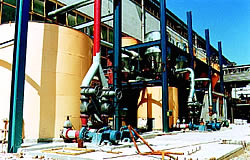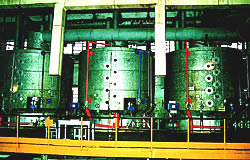|
||||
|
|
|
|
||||||||||||
|
|||||||||||||
Carbon dioxide is introduced into the limed juice where the sugar-lime breaks down and a sediment of calcium carbonate is formed, which is insoluble and holds the non sugars, as well as a solution of sugar. The lime and the carbon dioxide are produced in the lime-kiln of the factory which is fed with lime-stone and coke.
 Filtration
Filtration(rotary filters and thickening filter)
The sediment of calcium carbonate containing the bound non sugars, lays down on the filters. The sweet juice is clear and contains ~1,6% non-sugars, ~12% sugar and ~86% water (thin) juice.
In order to remove the water, wherein sugar is dissolved, the thin juice gets through a row of sucessive evaporation. The last one works at a pressure lower than the atmospheric. The vapour derived from the first evaporation vessel is recovered and used for heating the next vessel and so on. This takes place five times (five-stage evaporation-thick juice). The evaporation station is useful not only for removing the water from thin juice, but at the same time for the distribution of vapour in all places where heating is needed (diffusion, juice purification, crystallization, sugar drying etc.)
 Thick juice is condensed to an increasing extent in apparatuses operating under vacuum. It thereby reaches a stage of super-saturation. By then the first sugar crystals appear in the juice. These crystals grow bigger and there results a mixture of crystal and syrup called “massecuite”.
Thick juice is condensed to an increasing extent in apparatuses operating under vacuum. It thereby reaches a stage of super-saturation. By then the first sugar crystals appear in the juice. These crystals grow bigger and there results a mixture of crystal and syrup called “massecuite”.
Industrial production |